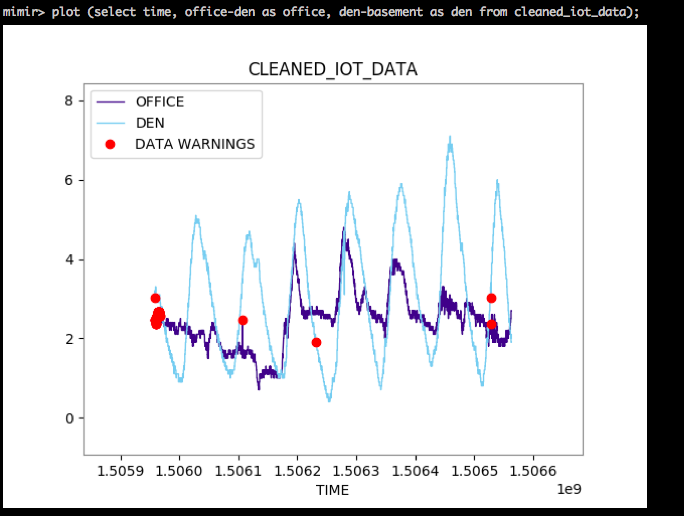Don't Wrangle, Debug
Exploring Online Data Interactions

Oliver Kennedy
A Big Data Fairy Tale
Meet Alice

Alice has a Store
 →
→
Alice's store collects sales data

Alice wants to use her sales data to run a promotion

So Alice loads up her sales data in her trusty database/hadoop/spark/etc... server.
 + ?
+ ?
... asks her question ...
 + ? →
+ ? →

... and basks in the limitless possibilities of big data.
Why is this a fairy tale?
 →
→

It's never this easy...
File Formats
(JSON/XML, CSV, 1000s of Files in Directories)
- Manually Explore Examples
- Automatic Summarization (Oracle Data Guides)
- Manual Segmentation (Log Data, Files)
Missing Data
(Sensor errors, Survey Data)
- Discover Outliers
- Fix (pick one): Don't guess wrong!
- Impute Missing Values
- Interpolate Missing Values
- Drop Rows with Missing Data
Documentation
("The CSV is in GIT")
- Rediscover Column/Variable Meanings
- Units / Measurement Techniques
- Caveats on Data Usage / Cleaning Techniques
- Make & Rediscover Assumptions About Data
Mimir & Family
- SchemaDrill
- JSON/Filesystem Schemas
- UADBs
- Data-Associated Documentation
- LOKI
- Automatic Reverse-Engineered Documentation
- Vizier
- Multi-Modal, Interactive Data Exploration
SchemaDrill
{ "foo" : 1, "bar" : 2 }
{ "foo" : 3, "bar" : 4, "baz" : 5 }
{ "baz" : 6, "frob" : 7 }
What's the schema of these objects?
SchemaDrill
{ "name" : "Alice", "address" : "123 A Street" }
{ "name" : "Bob", "address" : "456 B Street", "city" : "Buffalo" }
{ "city" : "Buffalo", "state" : "New York" }
What's the schema of these objects?
SchemaDrill
{ "restaurant" : "10-21", "menu" : ["Wings", "Beer"] }
{ "restaurant" : "11-21", "menu" : ["Gnocchi"], "bar" : "17-00" }
{ "bar" : "18-02", "patio" : true }
What's the schema of these objects?
SchemaDrill
- Does a collection of objects encode one type of entity or multiple?
- Non-Negative Matrix Factorization
- Does a nested array / object represent a tuple or a collection?
- Key Entropy (higher → more collection-like)
- Type Entropy (higher → more tuple-like)
UADBs
Classical Ways to Query Uncertain Data
- Certain Answers: Answers we're $100\%$ confident in.
- Possible Answers: Answers we're $>0\%$ confident in.
- Best-Guess Answer: Some internally self consistent answer that looks right.
Certain is principled; Best-Guess is fast.
UADBs
- Mark possibly erroneous inputs
- Trace marks through queries
- Automatically mark outputs
UADBs

UADBs
- How do we efficiently compute which results are based on marked inputs?
- Can we guarantee that all marked outputs depend on marked inputs?
- How do we tie these results to existing encodings uncertain data?
LOKI
Label Once and Keep It
 Vizier
Vizier

 Vizier
Vizier

 Vizier
Vizier

 Vizier
Vizier

| Students | |||
|---|---|---|---|

Poonam |

Will |

Aaron |

Mercy |
| Dev |
|---|

Mike |
| Alumni | ||||||
|---|---|---|---|---|---|---|

Ying |

Niccolò |

Arindam |

Shivang |

Olivia |

Gourab |
|
| External Collaborators | |||||
|---|---|---|---|---|---|
|
Dieter Gawlick (Oracle) |
Zhen Hua Liu (Oracle) |
Ronny Fehling (Airbus) |
Beda Hammerschmidt (Oracle) |
Boris Glavic (IIT) |
Su Feng (IIT) |
|
Juliana Freire (NYU) |
Wolfgang Gatterbauer (NEU) |
Heiko Mueller (NYU) |
Remi Rampin (NYU) |
Sonia Castelo Quispe (NYU) |
Mimir is supported by NSF Awards ACI-1640864, IIS-1750460, and gifts from Oracle. Prior support from NPS Award N00244-16-1-0022.